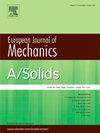基于切向插值的全机多输入多输出模态分析改进版
IF 4.4
2区 工程技术
Q1 MECHANICS
引用次数: 0
摘要
在结构动力学领域,模态分析是系统识别和振动检测的基础。然而,尽管得到了广泛应用,目前从多输入多输出(MIMO)频域数据中提取模态参数的最先进方法仍受到许多技术限制的影响。主要是计算繁琐和/或受到近频模态的负面影响。最近提出的 Loewner 框架(LF)可以缓解这些问题,但其局限性在于只能处理单输入数据。这项工作提出了一个计算改进版的 LF,即 iLF,以更有效地提取模态参数。同时,为了处理频域中的多输入多输出数据,对所提出的实现方法进行了扩展。在数值和实验数据集上,将这种新的实现方法与最先进的方法(如最小平方复指数法的频域实现方法和子空间状态空间系统识别的数值算法)进行了比较。更具体地说,三维欧拉-伯努利波束的有限元模型用于基线比较和所提 MIMO iLF 算法的噪声鲁棒性验证。然后,在实际应用中选择了来自一架教练喷气式飞机 MIMO 地面振动测试的实验数据集,该数据集拥有超过 91 个加速度计通道,用于算法验证。该算法与同一飞机右侧机翼单输入多输出数据集的已知结果进行了验证。在数值数据集和实验数据集上,所提出的改进型 MIMO 方法在精确度、对噪声的鲁棒性和计算性能方面都取得了优异的结果。MIMO iLF MATLAB 实现在工作补充材料中共享。本文章由计算机程序翻译,如有差异,请以英文原文为准。
Improved tangential interpolation-based multi-input multi-output modal analysis of a full aircraft
In the field of Structural Dynamics, modal analysis is the foundation of System Identification and vibration-based inspection. However, despite their widespread use, current state-of-the-art methods for extracting modal parameters from multi-input multi-output (MIMO) frequency domain data are still affected by many technical limitations. Mainly, they can be computationally cumbersome and/or negatively affected by close-in-frequency modes. The Loewner Framework (LF) was recently proposed to alleviate these problems with the limitation of working with single-input data only. This work proposes a computationally improved version of the LF, or iLF, to extract modal parameters more efficiently. Also, the proposed implementation is extended in order to handle MIMO data in the frequency domain. This new implementation is compared to state-of-the-art methods such as the frequency domain implementations of the Least Square Complex Exponential method and the Numerical Algorithm for Subspace State Space System Identification on numerical and experimental datasets. More specifically, a finite element model of a 3D Euler–Bernoulli beam is used for the baseline comparison and the noise robustness verification of the proposed MIMO iLF algorithm. Then, an experimental dataset from MIMO ground vibration tests of a trainer jet aircraft with over 91 accelerometer channels is chosen for the algorithm validation on a real-life application. Its validation is carried out with known results from a single-input multi-output dataset of the starboard wing of the same aircraft. Excellent results are achieved in terms of accuracy, robustness to noise, and computational performance by the proposed improved MIMO method, both on the numerical and the experimental datasets. The MIMO iLF MATLAB implementation is shared in the work supplementary material.
求助全文
通过发布文献求助,成功后即可免费获取论文全文。
去求助
来源期刊
CiteScore
7.00
自引率
7.30%
发文量
275
审稿时长
48 days
期刊介绍:
The European Journal of Mechanics endash; A/Solids continues to publish articles in English in all areas of Solid Mechanics from the physical and mathematical basis to materials engineering, technological applications and methods of modern computational mechanics, both pure and applied research.

 求助内容:
求助内容: 应助结果提醒方式:
应助结果提醒方式:


